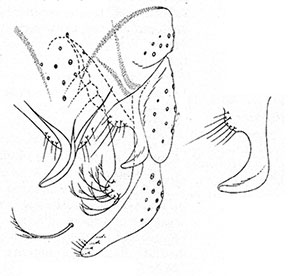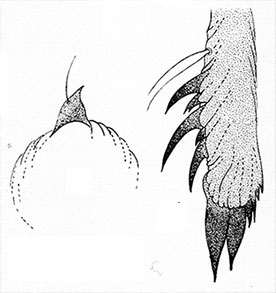|
Chironomus claggi Tokunaga 1964 In BOLD Bin: BOLD:ACQ6925. Adult Large yellow and dark brown or brown species. Body length 5.33 (5.01-5.66) mm, Wing length 2.67-2.69 mm; width 0.68-0.72 mm., crossvein not darkened, VR about 1. Frontal tubercles cylindrical about the length of 2 eye facets. Palps brown, segment lengths: 15.5 : 16.5 : 70.5 : 70.5 : 84; P5/P4 & P5/P3 1.19; AR 2.7 (2.5-2.85). Thorax widely yellow, vittae entirely yellow, scutum white. 9-11 small setae in anterior row and 10-11 larger setae in posterior row (total 19-22) on scutellum. Legs with coxae and trochanters usually yellow, all femurs mainly yellow but apically brownish, fore tibia mainly dark but other tibiae dark only on basal parts; fore tarsi entirely black or dark brown, other tarsal segments pale or yellowish brown on basal 1 or 2 segments but apical part black or more brownish as on following segments; LR 1.7 (1.66-1.77); Fe1/Ti1 1.22. Abdomen mainly very pale brown, but TII-VI with basal bands brown and broad, other segments uniformly brown. TIX with about 8 setae in a pale area.  Hypopygium and superior volsella of C. claggi from Tokunaga 1964 Superior volsella of the dorsalis-type, closest to S-type of Strenzke (1959), similar to that of C. indiaensis. Inferior volsella long, to half way along gonostylus, setae bi- or trifurcate apically; gonostylus moderately swollen and reduces gradually over posterior third. Anal point narrowed at base. Superior volsella a boot shape closest to S-type of Strenzke (1959), similar to that of C. indiaensis. Setae of inferior volsella bi- or trifurcate apically.Female:
Wing length 3.04 mm, width 0.89 mm. LR about 1.81. Frontal tubercles about 1.5 times as long as the diameter; palp proportions about 20 : 18 : 70.5 : 82.5 : 107; P5/P4 1.30, P5/P3 1.52. Pupa: It is not clear whether this known pupa is definitely associated with this species. It was collected along with a female, but there is no detail as to how they were associated - the caudo-lateral spur is rather unusual for a Chironomus species, more like that of a Stictochironomus, as is a "rounded" anal swim fin. With that proviso, Tokunaga's description gives the following information:  Pupal cephalic tubercles and spur of C. claggi from Tokunaga 1964 Larva and Cytology: Not known. Found: Type localities - Futami-ko; Camp Beach, Omura; Gen's beach, Minato-ko, Yatsue Region; all Chichi Jima, Micronesia. According to Yamamoto & Yamamoto (2018), C. claggi superficially resembles C. flaviplumus and C. yoshimatsui but is separable by the more slender superior volsella. In scutal coloration and superior vollsella shape it resembles C. circumdatus. DNA Sequence: |
Created: 3 March 2023
Access: Unrestricted
Copyright © 2019-2023, Jon Martin.